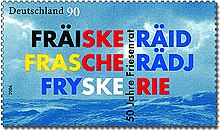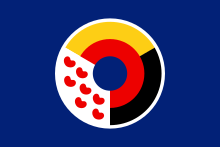Frisian Council
The Frisian Council or Inter-Frisian Council represents the overall Frisian interests externally. It is composed of representatives from the three local Frisian councils. The Frisian Council is a representative of the Frisian ethnic group in the Frisian committee of the Schleswig-Holstein state parliament. He is also represented in the Dutch department of the European Bureau for Linguistic Minorities .
The sections
Each of the so-called three Friesland regions has its own Frisian Councils, which are very different in their structures. The presidency of the Inter-Frisian Council rotates between these three sections every three years. Currently, from 2009 to 2012, the chairmanship lies with the West Section, President is Dr. Roel Kaastra from Ald Beets ( Opsterland ), the manager is Froukje de Jong from St. Anne ( Het Bildt ).
-
 Section West:
Section West:
- Self-designation in West Frisian : Fryske Rie
- Work area: Fryslân province in the Netherlands
- Official seat: Ljouwert / Leeuwarden (Fryske Akademy)
- Chairman: Roel Kaastra
- Secretary: Saapke Miedema
-
 Section East:
Section East:
- Self-designation in Sater Frisian : Fräiske Räid and in Low German Freeske Raad
- Work area: East Friesland , Oldenburger Friesland , municipality of Saterland , the former Rüstringen and the state of Wursten in Lower Saxony ( East Friesland )
- Official seat: Auerk / Aurich ( East Frisian Landscape )
- Chairman: Gerhard Cordes
-
 Section North:
Section North:
- Self-designation in North Frisian : Frasche Rädj
- Work area: North Friesland and Heligoland in Schleswig-Holstein
- Official seat: Bräist / Bredstedt
- Chair: Ilse Christiansen
- Managing director: Frank Nickelsen
Regular events
Every third year, at the end of a Council Presidency, the Friesian Council organizes the so-called Friesian Congress in one of the three Frieslandes. A year later, the council also organizes the Friesen-Droapen cultural festival on Heligoland, which attracts an average of around five hundred visitors. Important regular activities of the Frisian Council are still the professional group meetings, at which different groups, such as B. involve farmers, rural women, students, teachers and local politicians.
history

Inter-Frisian contacts were particularly strong between West Frisians and North Frisians since the 19th century. In 1925 the first Frisian congress (which was only later called) took place in Jever , organized by Peter Zylmann . In the course of follow-up events, the Frisian Council was planned from 1928 and was finally founded in Husum in 1930 .
The relationship of the Friesenrat to National Socialism was ambivalent. The Frisian Council initially acted emphatically apolitical, as it was viewed with suspicion by both the German and Dutch governments. In addition, the National Socialists feared “the influence of the International” and were opposed to “international congresses in the style of Judaism”.
At the latest after the occupation of the Netherlands by German troops in 1940, the Nazi state wanted to use the Frisian connections to win the Dutch Frisians on their side with their ethnic ideology. For this purpose, quite a few East Frisians and also some West Frisians were instrumentalized. A (overall) Frisian movement would not have been in the interests of the National Socialists in the long term.
In particular, the Dutch Frisians are to be thanked for the new merger, as they again shook hands with the Frisians in Germany despite the previous war . A Frisian congress was held again as early as 1952. In 1955 the Frisian Manifesto was adopted in Aurich am Upstalsboom , which now put the inter-Frisian movement in relation to European unification. In 1956 the Frisian Council was finally re-established in Leer . Some of the individual Frisian councils or sections were not registered as associations or foundations until much later (the Fryske Rie not until 1981). The Frisian Councils only officially came together in 1999 under the name Interfriesischer Rat eV .
For the 50th anniversary of the Frisian Council, the Federal Republic of Germany issued a special stamp on February 9, 2006 .
flag
In June 2009 the Inter-Frisian Council adopted a flag that is to be considered the all-Frisian flag, after the Groep fan Auwerk had presented an Inter-Frisian flag at the 2007 Frisian meeting on Heligoland. The flag of the Frisian Council shows a ring on a "European blue" background, which is based on the historical flags of the three sections and shows their colors in the geographical arrangement of the three Friesland. The reference to the European flag is intended to show that the Frisians are convinced Europeans, as they called for European unification in the Frisian Manifesto in 1955. The circle stands for the unity of the Frisians. This explicitly modern flag design prevailed over traditional and historical proposals in the previous selection process.
literature
- Thomas Steensen : On the origin and development of inter-Frisian relationships. In: Horst Haider Munske (Hrsg.): Handbuch des Frisian. = Handbook of Frisian Studies. Niemeyer, Tübingen 2001, ISBN 3-484-73048-X , pp. 698-703.
- Thomas Steensen (Ed.): The Frieslande (= Nordfriisk Instituut. No. 187). Nordfriisk Instituut, Bräist / Bredstedt 2006, ISBN 3-88007-333-3 .
Web links
- Inter-Frisian Council
- Frisian Council Section North
- Frisian Council Section West
- The Frisian Council (East Section)
Individual evidence
- ^ Frank Nickelsen: The Inter-Frisian Council . In: interfriesischerrat.de .
- ^ Frank Nickelsen: Inter-Frisian flag . In: interfriesischerrat.de .

